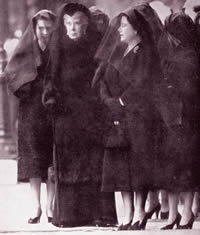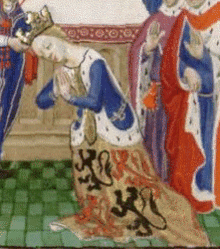
This continuous presence of reigning and dowager consorts is unusual in English history. From the death of Queen Henrietta Maria, Dowager Queen during the reign of her son King Charles II, in 1669 to the ascension of Queen Victoria, daughter of the Duchess of Kent, in 1837, the royal family did not include a living “Queen Mother.” It is necessary to go further back in history to find another continuous series of queens dowager and consort. In Three Medieval Queens: Queenship and the Crown in Fourteenth-Century England, Lisa Benz St. John, the 2011-2012 Visiting Medieval Fellow at Fordham University, analyzes queenship in the fourteenth century, a period filled with fascinating royal wives and mother.
In common with the twentieth century, the monarchy of this period had successive queen consorts and dowager queens who influenced their daughters-in-law. King Edward I’s second wife, Margaret of France was Dowager Queen when her stepson, King Edward II, married her niece Isabelle of France. Isabelle was regent for her son, King Edward III, when he married Philippa of Hainault.
This unusual succession of queens dowager and consort allows St. John to analyze the broader role of the queen in the fourteenth century English monarchy. As royal wives, mothers and widows, Margaret, Isabelle and Philippa were expected to act as intercessors between the King and his subjects, excercise patronage, run their households, influence the upbringing of their children, and, less frequently, administrate the realm. There may not have been any treatises written in the fourteenth century on the role of the queen but Margaret, Isabelle and Philippa faced clear expectations when they became English royal consorts.
St. John structures her work as a thematic study of fourteenth century queenship rather than three successive biographies of the consorts of Edward I, Edward II and Edward III. This approach demonstrates the continiuty that existed in the role of the queen consort despite the political upheaval of the period. Margaret, Isabelle and Philippa all appear to have learned from the example of their predecessors and adapted these traditions to their individual marriages and circumstances.
For readers interested in the biographical details of these three queens, the known details of their personalities emerge from St. John’s analysis of their duties and activities. Margaret appears to have initially enjoyed a cordial relationship with her stepson, Edward II until she objected to his patronage his favourite Piers Gaveston. Isabelle’s conflict with her husband emerged from his close relationship with a subsequent favourite, Hugh Despenser, which similarly upset the accepted patronage structure at court.

In the final chapter of Three Medieval Queens, “Administrator of the Realm,” St. John provides a balanced assessment of Isabelle’s controversial queenship and regency. As consort to Edward II, her household already contained armed knights for her status and security and her influence over her son was an accepted aspect of her queenship. Her rule on behalf of Edward III was initally accepted by the nobility as restoring the political balance upset by Edward II’s favourites until her policies became unpopular. Even after Edward III assumed power in his own right, Isabelle did not become an ostracized “she wolf” but a respected Dowager Queen. This chapter is so important to the historiography of Queen Isabelle that it should probably be placed closer to the beginning of the book.
Three Medieval Queens: Queenship and the Crown in Fourteenth-Century England is written for scholars of medieval English history and queenship but it will appeal to general readers interested the unique role of the queen in fourteenth century England and a balanced portrait of the notorious Queen Isabelle.

